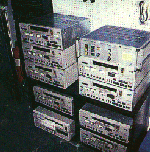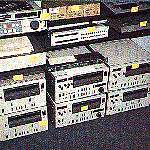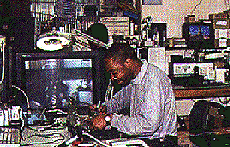Bob Tomalski (RIP)- formally the UK's leading technology journalist discovers U-matic.
This article first appeared in Camcorder User January 1997
 |
 |
Often considered to be an obsolete format, second-hand U-matic kit can provide excellent results - and at bargain prices. Bob Tomalski investigates
The £40 machine came with six free cassettes, as it turned out, carried top-secret training material used by the British Army in Northern Ireland. The story was the lead item on the BBC's Nine o-clock news and has subsequently featured in a Carlton TV documentary.
In the three days that I owned the machine ( it was seized as evidence by the Ministry of defence police ) I coupled it to a Sony DCR-VX7000 camcorder and made some DV-to-U-matic composite dubs.
I was amazed to discover that the U-matic transfers were markedly superior to S-VHS copies of the same material - even though S-VHS is supposedly better.
Given that U-matic equipment is now going for a song on the second-hand market, I investigated its possibilities for the enthusiastic amateur.

Here's the good, the bad and the ugly of going 3/4 inch on a shoestring...
First what is U-matic? Basically it's a video format that has stood the test of time. Conceived in the 1970s, it was the first video cassette format to come out of Japan.
Using 3/4in tape, the format has a writing speed of 8.7 metres/sec compared with that of 4.85 metres/sec for VHS/S-VHS. The track width is 80 microns compared with 49 microns of VHS. In layman's terms, this means there is more latitude when recording and replaying signals. This shows up as less when dubbing down a generation.
And it isn't the picture performance that potentially has the edge. U-matic has two high-quality edge tracks that extend from 50Hz to 15kHz thanks to the relatively high linear speed of the tape. Although the frequency response and distortion levels are inferior to FM - as used by VHS/S-VHS Hi-Fi - the soundtracks offer full creative possibilities as they can be over dubbed at will.
 Originally, the U-matic system was used by colleges and companies as an
industrial video format. With the introduction of high-band, t was seized upon
as a broadcast acquisition/editing format.
Originally, the U-matic system was used by colleges and companies as an
industrial video format. With the introduction of high-band, t was seized upon
as a broadcast acquisition/editing format.
When professional alternatives such as Panasonic's MII and Sony's Betacam came along, it was assumed that U-matic would suffer instant death as organisations turned to new technology.
It wasn't so. Many companies - particularly advertising agencies - retained their U-matic machines because they were reliable and because they had become the de facto standard within the industry.
Despite this, U-matic has been abandoned as a broadcast medium, which in turns means a flood of surplus equipment has entered the second-hand market at prices that are affordable to home users.
Could the keen amateur be better off using such machinery rather than the latest domestic editing equipment?
PROFESSIONAL ADVICE
I spoke to Bob Armstrong who runs LRC ( London Repair Centre ) which services professional video equipment for broadcasters and facility houses. He also buys, sells and hires ex-broadcast equipment.'Take something like this', he says. 'It cost around £20,000 when new and was the mainstay of BBC TV. Fifteen years ago, all programmes were played on such machines. Today it's obsolete. It's really only worth a few hundred pounds for its scrap value, yet it remains a high-quality, broadcast machine. If you get one and the head's good, you've got a bargain.
'It's hardly ideal for the home as it weighs around 70kg, You couldn't put it on your living room table! But for a third-world broadcaster or a facilities house that needs to dub old 1 in archive material, it's ideal!
DO YOUR HOME WORK
Given the complexity and wide range of professional gear, what advice could Bob give to potential buyers?

'Do your homework. It's just like buying a used car. Shop around. You'll find that prices vary enormously depending upon whether you buy privately of from a dealer.
'You can buy old U-matic machines from car boot sales, ham radio rallies and magazine advertisements, but it's a case of the buyer beware!
'If the head has gone on an edit deck you'll be talking around £600 to replace it. Frankly, I wouldn't sell such equipment. When I sell a machine I always guarantee it for three months and ensure that it's in pristine condition.
'So what should you watch out for when buying such equipment?
'The Sony RM-440 editor is a great piece of kit,' confirms Bob. 'It's accurate to around two frames, and performs audio and video insert edits automatically. But always ensure it's supplied with control cables. If not, you're looking at over £250 for a new set.
' Another caveat is mixing and matching brands. A Panasonic F250 camera head will fit a Sony Hi8 back-end, but only if you have an adaptor plate that costs £1500.'
CHECKING EQUIPMENT
Wandering into Bob's service department, I caught sight of a U-matic machine on a bench having new heads fitted. I asked Bob if it's possible to tell whether a machine will be reliable just from the condition it's in?'With used equipment don't assume that a clean exterior means a faultless
machine. Anyone can go over it with a can of polish.' Says Bob.

'Try to take the top off the machine and have a look inside. A mucky pinch-roller is a fair indication that the indication that the equipment is desperately in need of a service. Give the machine a run through. What is the picture like? Does the deck make horrible noises? Does it respond swiftly to key presses? All these factors should help you make an assessment.'
Looking around Bob's video emporium I spotted a host of professional products using a variety of professional formats. Betacam, U-matic, high-band, Hi8, open-reel - the list was endless. But which should we choose?
'Try to match your acquisition format to your editing.' advises Bob. There's very little point going for a U-matic edit suite if you're capturing pictures on Hi8. The transfer losses are just too great. You would be better off with a Panasonic F10 or F15 camera and a Sony VO-4800 or VO-6800 portable U-matic recorder.
'An alternative is to consider originating on DV. We've found this copies to U-matic very well. On the first dub, the losses are minimal, even when copying from composite-to-composite.'
On the subject of U-matic dubbing, Bob adds: 'Always use the dub terminals if you can. Edit machines allow a direct RF signal to be copied, bypassing all video processing. You get much lower noise by using this terminal on edit and play machines.
'There are also a few second-hand machines to avoid, such as the old 28000-series U-matic decks. There are huge top-loaders from the 1970s. Spares are rare and performance can be suspect.'
I asked Bob if there were many dealers in Britain specialising in pro kit.
'Not many,' replied Bob. 'Maybe five or six key players and another 20 or so smaller firms. Our key customers are not Saturday wedding videographers, but individuals that get commissions to produce programmes for satellite, cable and Channel 4.
'We also have a lot of customers in the advertising community and independent producers shooting corporate productions, it continues as a popular format for rushes because it's reliable and resilient.
'In my book it beats VHS any day. VHS is great for time shifting EastEnders, but for editing? In this respect, VHS stands for 'Very Horrible System'

Camcorder User is a WV publication
